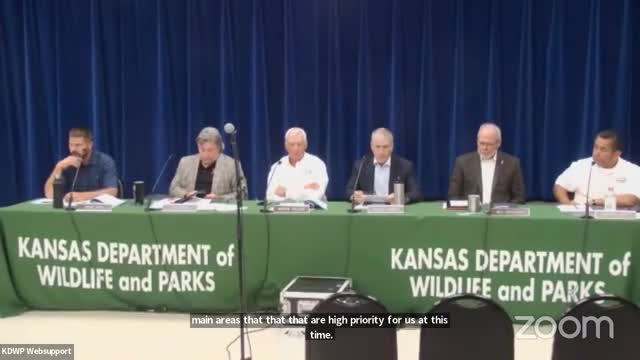Coyote control strategies spark debate over wildlife management
October 03, 2024 | Department of Wildlife & Parks, State Agencies, Organizations, Executive, Kansas
This article was created by AI summarizing key points discussed. AI makes mistakes, so for full details and context, please refer to the video of the full meeting. Please report any errors so we can fix them. Report an error »

During a recent government meeting, wildlife management officials discussed the ongoing issues surrounding coyote hunting and predator control, particularly focusing on the use of night vision technology. Matt Peek, a wildlife research biologist, presented findings on predator control strategies and the implications of coyote populations in Kansas.
Peek emphasized that predator control is often a contentious topic, particularly when prey populations decline. He noted that public interest in predator control tends to rise when game species, such as turkeys and pheasants, experience population drops. He addressed common public perceptions, including the belief that predator numbers have surged due to a decline in trapping activities. However, he clarified that while raccoon and coyote populations have increased, other species like possums and skunks have not shown similar growth.
The biologist presented data from a long-term furbearer survey, indicating that raccoon populations have steadily increased since 1980, while possum and skunk numbers have slightly decreased. He explained that the relationship between predator harvest and population levels is complex, asserting that legal harvest does not necessarily dictate population dynamics. For instance, despite a significant drop in raccoon harvest from 90,000 to 40,000 pelts annually, the population did not decline proportionately.
Peek also discussed the effectiveness of bounty programs for predator control, stating that they often fail to yield significant increases in prey populations. He highlighted that while bounties might recruit new trappers and raise public awareness about furbearer management, they do not effectively address the underlying issues of predator populations.
The conversation shifted to the controversial topic of night vision coyote hunting, which has been permitted since 2020. Peek noted that while this method has increased coyote harvest numbers, it has also raised concerns among traditional hunters about its impact on their success. Law enforcement officials expressed difficulties in monitoring night hunters, leading to concerns about illegal activities such as hunting from vehicles and trespassing.
Despite these challenges, the committee overseeing furbearer management does not plan to restrict night vision hunting but is cautious about expanding its parameters. The officials acknowledged the recreational value of coyote hunting while emphasizing the need for responsible management practices.
In conclusion, the meeting underscored the complexities of predator management in Kansas, highlighting the balance between recreational hunting, wildlife population dynamics, and the challenges posed by modern hunting technologies. The department plans to continue monitoring coyote populations and harvest levels while focusing on habitat management as a primary strategy for wildlife conservation.
Peek emphasized that predator control is often a contentious topic, particularly when prey populations decline. He noted that public interest in predator control tends to rise when game species, such as turkeys and pheasants, experience population drops. He addressed common public perceptions, including the belief that predator numbers have surged due to a decline in trapping activities. However, he clarified that while raccoon and coyote populations have increased, other species like possums and skunks have not shown similar growth.
The biologist presented data from a long-term furbearer survey, indicating that raccoon populations have steadily increased since 1980, while possum and skunk numbers have slightly decreased. He explained that the relationship between predator harvest and population levels is complex, asserting that legal harvest does not necessarily dictate population dynamics. For instance, despite a significant drop in raccoon harvest from 90,000 to 40,000 pelts annually, the population did not decline proportionately.
Peek also discussed the effectiveness of bounty programs for predator control, stating that they often fail to yield significant increases in prey populations. He highlighted that while bounties might recruit new trappers and raise public awareness about furbearer management, they do not effectively address the underlying issues of predator populations.
The conversation shifted to the controversial topic of night vision coyote hunting, which has been permitted since 2020. Peek noted that while this method has increased coyote harvest numbers, it has also raised concerns among traditional hunters about its impact on their success. Law enforcement officials expressed difficulties in monitoring night hunters, leading to concerns about illegal activities such as hunting from vehicles and trespassing.
Despite these challenges, the committee overseeing furbearer management does not plan to restrict night vision hunting but is cautious about expanding its parameters. The officials acknowledged the recreational value of coyote hunting while emphasizing the need for responsible management practices.
In conclusion, the meeting underscored the complexities of predator management in Kansas, highlighting the balance between recreational hunting, wildlife population dynamics, and the challenges posed by modern hunting technologies. The department plans to continue monitoring coyote populations and harvest levels while focusing on habitat management as a primary strategy for wildlife conservation.
View full meeting
This article is based on a recent meeting—watch the full video and explore the complete transcript for deeper insights into the discussion.
View full meeting
